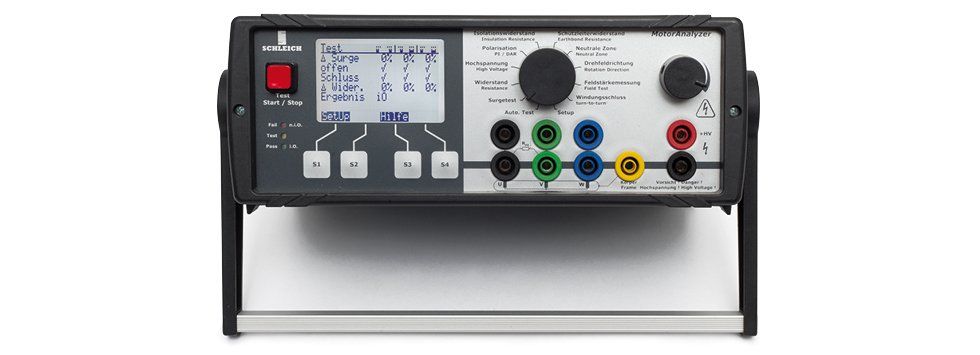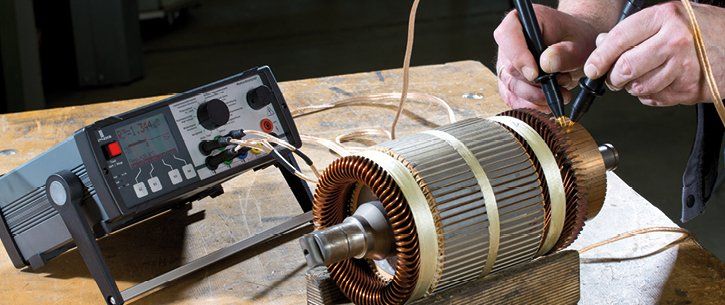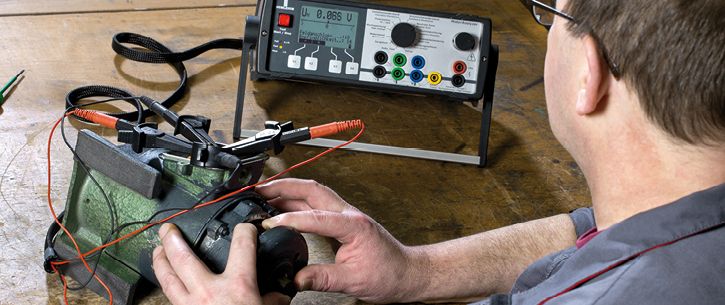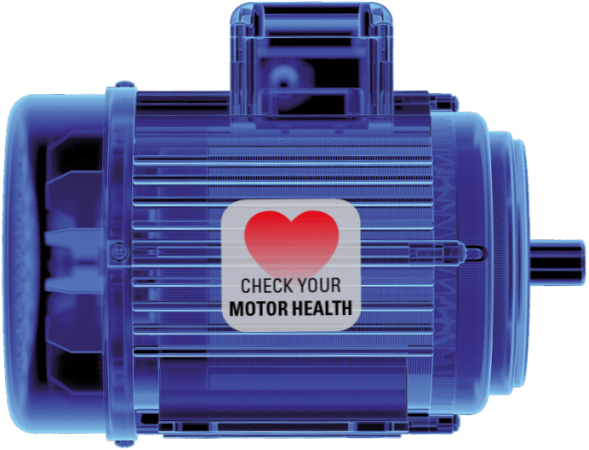MotorAnalyzer1 Universal tester for electric motors and windings
The MotorAnalyzer1 is a universal tester for testing electric motors
and windings. It combines 10 different test methods in a user-friendly
and mobile device. The combination of test methods, the compact
design and the battery operation make the MotorAnalyzer1 an ideal
tool for on-site use – even if the DUT is diffi cult to access.
MotorAnalyzer1 The entry-level device for your motor service
Compact design and a wide range of applications for troubleshooting in windings that are not live are the distinguishing features of this tester. Ten reliable tests and test methods are built in. Due to its integrated rechargeable battery, tests can also be performed off-grid, without a power connection. It is a versatile tool for electrical engineering, motor repair, maintenance and servicing.
The versatile instrument.
Our MotorAnalyzer1 is a universal tester for electric motors and winding goods. It unites ten different test methods in one user-friendly and portable device. The combination of test methods, its ultra-compact design and the battery powered operation make the MotorAnalyzer1 the perfect tool for on-site use – particularly in difficult mounting locations.
To test an electric motor, the three winding leads and the motor housing are wired to the tester. The surge voltage and resistance tests are set in motion automatically. Subsequently, the motor is submitted to a high-voltage test in order to assess the quality of the motor in a fast and accurate manner.
MotorAnalyzer1 was designed for both in-house and on-site use. Off-grid battery mode lets you test electric motors (e.g. on a crane) accurately even in complex mounting locations. With MotorAnalyzer1 the user will have the ability to make a definitive GO/NOGO-assessment using all built-in test methods and advanced software diagnostics with superior visual support on-screen.
10 test methods in 1 device
Universal stator-, armature-, motor- and transformer-tester
10 test methods
autotest
surge voltage
resistance
high voltage DC
polarization index
insulation resistance
PE/GB-resistance
“neutral zone”-adjustment for DC motors
rotary field on stator or motor
winding fault location with a test probe for stator and armature
rotating switch for quick test method selection
automatic switchover between the three motor connection cables
built-in test result log
data transfer to PC via RS-232 or USB interface
easy-to-read large-screen graphics display
off-grid battery operation with battery status indicator
lightweight
Windows®-software for importing test results and printing test reports
Technical specifications overview.
Power supply
- built-in battery
- external charger
Autotest
- automatic stator-, motor- and winding testing
- automated fault detection
Surge voltage
- automatic and manual surge voltage tests
- 1-, 2- and 3-phase
- Visual representation of the surge wave
- automated analysis
Resistance
- 1-, 2- and 3-phase
- Imbalance analysis
- precision 4-wire measurement
- Temperature compensation
Insulation resistance
- 0 – 4.000 V
- up to 100 GΩ
- manually adjustable
- auto-programmable
- in accordance with VDE 0701
Polarization index
- 0 – 4.000 V
- PI-measurement
- DAR-measurement
- automated measurement cycle
High voltage DC
- 0 – 4.000 V
- manually adjustable
- auto-programmable
- Voltage measurement in stages
PE/GB-resistance
- in accordance with VDE 0701
“Neutral zone” in DC motors
- visual indication of the deviation of the ideal brush adjustment via a bar graph
- acoustic indication of the deviation of the ideal brush adjustment via acoustic signal
Rotary field
- stator-rotary field measurement
- motor-rotary field measurement
Winding fault location
- winding fault location with a test probe
- visual indication of the winding fault location via a bar graph
- acoustic indication of the winding fault location via acoustic signal
⇒ Find more details PDF here
NAICS Codes
334515,
54138, 811219,811310
Cage Code
4P2J9
Duns Number
79-119-1351
Contact Info:
MOTOR DIAGNOSTIC SYSTEMS, INC.
inside.sales@mdsusa.net
Sales: +1 (970) 461-1348
or +1(877) 461-1348
Fax: +1 (866) 223-0800
Business Hours
- Mon - Fri
- -
- Sat - Sun
- Closed
All Rights Reserved | Motor Diagnostic Systems Powered by The Way Consulting






